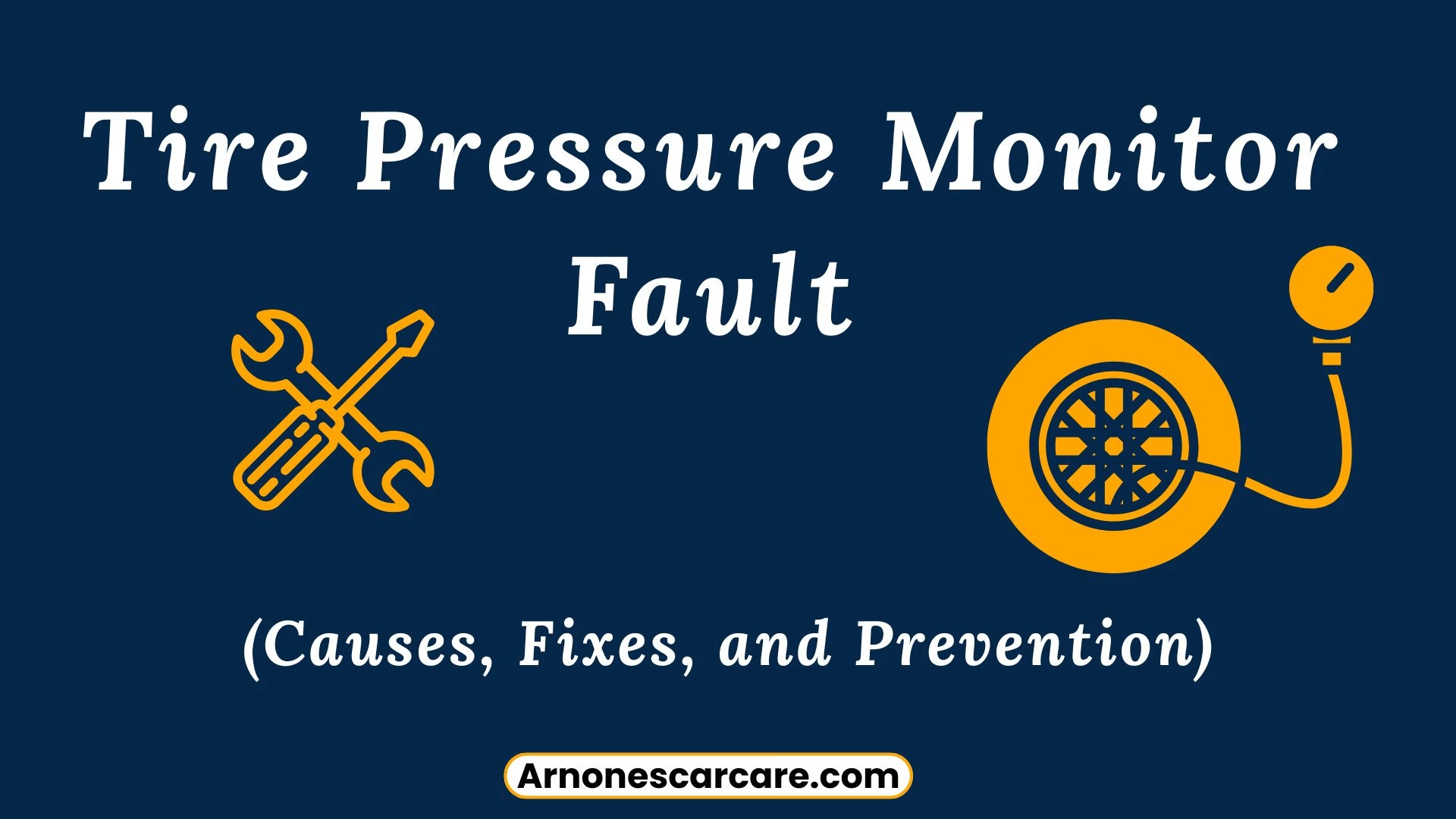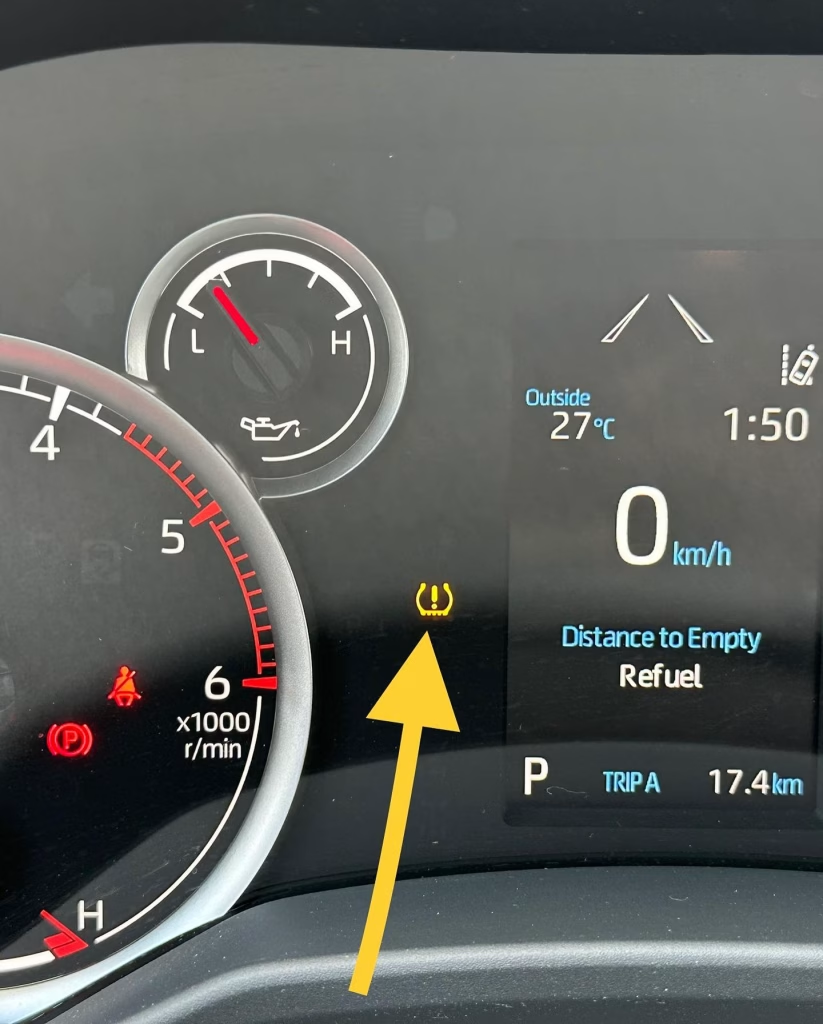
A Tire Pressure Monitoring System (TPMS) helps track tire pressure and alerts you if it’s too low or too high. A Tire Pressure Monitor fault means the system isn’t working correctly, often due to sensor damage, low tire pressure, battery failure, or interference. Ignoring this issue can lead to poor fuel efficiency, uneven tire wear, or even accidents.
Fixes include checking tire pressure, resetting the system, replacing faulty sensors, or updating software. Regular maintenance, careful driving, and protecting sensors from corrosion help prevent problems. In this blog, we will cover TPMS faults in detail, including causes, fixes, and preventive measures to keep your vehicle safe.
You can learn more about Tire Sizes for different vehicles.
What Is A Tire Pressure Monitoring System?
A Tire Pressure Monitoring System (TPMS) is a built-in safety feature designed to keep track of your vehicle’s tire pressure. It helps prevent issues caused by underinflated or overinflated tires, such as poor fuel efficiency, uneven tire wear, and even accidents.

Tire Pressure Monitor Fault Meaning and Purpose
The TPMS constantly monitors your tire pressure and alerts you if it drops below the recommended level. When a problem is detected, you’ll see a warning light on the dashboard. This is your car’s way of telling you to check your tires.
By maintaining the correct tire pressure, TPMS plays a crucial role in:
- Enhancing safety – Properly inflated tires improve traction, stability, and braking performance.
- Increasing fuel efficiency – Underinflated tires create more rolling resistance, making the engine work harder and consuming more fuel.
- Extending tire lifespan – Uneven tire pressure can lead to premature wear, reducing the life of your tires.
Types of TPMS
There are two types of TPMS used in modern vehicles:
1. Direct TPMS
Direct TPMS uses individual sensors inside each tire to measure real-time air pressure. These sensors send data to the car’s onboard computer, which then displays the tire pressure readings on your dashboard.
✔ Advantages:
- More accurate than indirect TPMS.
- Provides real-time pressure readings for each tire.
- Can detect gradual leaks and temperature changes.
✖ Disadvantages:
- More expensive to install and replace.
- Sensor batteries wear out over time, requiring maintenance.
2. Indirect TPMS
Indirect TPMS doesn’t measure air pressure directly. Instead, it relies on your car’s ABS (anti-lock braking system) sensors to track wheel speed. If a tire is underinflated, it will rotate at a different speed than the others, triggering the TPMS warning light.
✔ Advantages:
- Less expensive than direct TPMS.
- No extra sensors needed, reducing maintenance costs.
- No need to replace batteries in tire sensors.
✖ Disadvantages:
- Less accurate—only detects significant pressure loss.
- Needs recalibration after inflating or replacing tires.
- Can give false alerts due to uneven tire wear or rotation.
How Does the Tire Pressure Monitoring System (TPMS) Work?
The Tire Pressure Monitoring System (TPMS) is designed to keep an eye on your vehicle’s tire pressure in real time. It helps prevent tire-related issues by alerting you when one or more tires are underinflated or overinflated. But how exactly does it work?

Direct TPMS: Measures Pressure Inside the Tire
Direct TPMS uses pressure sensors inside each tire to track air pressure. These sensors are usually attached to the valve stem or mounted inside the tire. Here’s how it works:
- Each tire has a sensor that measures air pressure and sometimes temperature.
- The sensors wirelessly transmit data to the vehicle’s computer system.
- If the pressure drops below or above the recommended range, the system triggers the TPMS warning light on the dashboard.
Indirect TPMS: Uses ABS Sensors to Detect Pressure Changes
Indirect TPMS doesn’t measure air pressure directly. Instead, it monitors wheel speed through the Anti-lock Braking System (ABS) sensors. Here’s how it works:
- When a tire loses air, its diameter decreases, causing it to rotate faster than the other tires.
- The system detects this speed difference and assumes a tire is underinflated.
- It then triggers the TPMS warning light on the dashboard.
Understanding Your Tire Pressure Warning Light
When the TPMS detects a tire pressure issue, it illuminates a warning light on your dashboard. This light typically looks like a horseshoe shape with an exclamation mark (⚠) in the middle.

- Light Stays On – This means a tire has dangerously low air pressure, possibly due to a slow leak or sudden air loss.
- Tire Pressure Sensor Fault Flashing and Then Turns Off – This usually indicates a problem with the TPMS system itself, meaning the sensors may not be working properly.
Understanding how TPMS works can help you prevent tire-related issues, improve fuel efficiency, and ensure a safer driving experience.
Common Causes of TPMS Faults
A TPMS fault occurs when the system is unable to correctly monitor tire pressure. While some issues are minor and easy to fix, others may require professional repair. Below are the most common causes of TPMS malfunctions.

1. Low Tire Pressure
Low tire pressure is the most common reason for a TPMS warning light. This can be caused by:
- Punctures or leaks – A nail or sharp object can create a slow leak.
- Temperature changes – Cold weather causes air to contract, leading to a temporary drop in pressure.
- Gradual air loss – Tires naturally lose a small amount of air over time.
If the warning light appears, check and inflate the tires to the recommended pressure.
2. TPMS Sensor Damage
The TPMS sensors are delicate components that can be damaged during tire changes or by road debris.
- Improper tire mounting can break the sensor inside the wheel.
- Harsh road conditions (potholes, rocks, or curbs) can cause impact damage.
A damaged sensor may need to be replaced to restore proper TPMS function.
3. Sensor Battery Failure
Each TPMS sensor is powered by a small battery, which typically lasts 5 to 10 years. Once the battery dies, the sensor stops transmitting data.
- A failing sensor battery will trigger a TPMS fault even if tire pressure is normal.
- Battery replacement often requires a new sensor, as most batteries are sealed inside the unit.
4. Corrosion
Over time, exposure to moisture, road salt, and extreme temperatures can cause sensor corrosion.
- Corroded valve stems can lead to leaks, sensor failure, or complete detachment.
- Battery life can be shortened due to corrosion-related damage.
Regular tire maintenance and cleaning can help prevent corrosion and extend sensor life.
5. Signal Disruption
TPMS sensors communicate with the vehicle’s computer through radio signals. However, these signals can be disrupted by:
- Interference from other electronic devices (radios, dash cams, or phone chargers).
- Faulty receiver modules that struggle to pick up sensor data.
If you suspect signal interference, try resetting the TPMS or consulting a mechanic.
6. Software Glitches
A TPMS warning may appear even when there’s nothing wrong due to a software error in the vehicle’s system.
- Outdated vehicle software may cause inaccurate TPMS readings.
- False warnings can occur after tire replacements or rotations if the system isn’t recalibrated.
A software update or system reset can often fix this issue.
7. Faulty Wiring or Electrical Issues
Since TPMS relies on electronic communication, any problem in the wiring or connections can prevent accurate readings.
- Loose or damaged wires can disrupt data transmission.
- Blown fuses or a faulty TPMS control module may cause the warning light to stay on.
A mechanic’s diagnosis is often required for electrical problems, as they may need specialized tools to find and fix the issue.
By understanding these common TPMS faults, you can take the right steps to fix the problem and keep your tires in top condition.
Diagnosing TPMS Faults
If your TPMS warning light turns on, it’s important to diagnose the issue before assuming it’s a sensor failure. Here are a few key steps to identify the root cause of the problem.
1. Manual Tire Pressure Check
Before looking at the TPMS system itself, check the tire pressure manually using a reliable pressure gauge.
- Locate the recommended tire pressure – You’ll find this in the vehicle’s manual or on the driver’s side door jamb.
- Measure each tire’s pressure – Unscrew the valve cap, press the gauge onto the valve stem, and record the reading.
- Inflate or deflate as needed – If any tires are low, add air to match the recommended level.
If the TPMS light turns off after driving a few miles, the issue was likely just low tire pressure.
2. Visual Inspection
Look for physical signs of damage that may be affecting the TPMS sensors or valve stems.
- Check valve stems – If they appear cracked, bent, or corroded, they may be leaking air.
- Look for sensor damage – If your TPMS sensors are mounted inside the wheels, damage can occur from tire changes or rough road conditions.
- Inspect tires for punctures or leaks – If air pressure is dropping frequently, a slow leak or small puncture may be the culprit.
3. Use Diagnostic Tools
For more precise troubleshooting, a TPMS scan tool or OBD-II scanner can help identify specific fault codes. If a specific sensor is faulty, the diagnostic tool will identify which one needs replacement.
- OBD-II Scanner – Plug into the vehicle’s diagnostic port to check for stored TPMS error codes.
- TPMS Relearn or Reset Tool – Some TPMS faults require the system to be recalibrated after a tire change or sensor replacement.
- Professional TPMS Diagnostic Tool – Mechanics use advanced TPMS tools to check sensor status, battery life, and signal strength.
By following these steps, you can pinpoint the exact cause of a TPMS fault and take the right action to fix it.
How to Fix Tire Pressure Sensor Fault?
Once you’ve diagnosed the issue, the next step is fixing the TPMS fault. Some solutions are simple, like adjusting tire pressure, while others may require sensor replacement or professional repairs.
1. Adjust Tire Pressure
One of the most common causes of a TPMS fault is low or high tire pressure. Follow these steps:
- Check tire pressure using a gauge.
- Inflate or deflate tires to match the recommended pressure (found in the owner’s manual or driver’s side door jamb).
- Drive for a few minutes. In many vehicles, the TPMS light will turn off automatically after correcting the pressure.
If the light remains on, additional troubleshooting is needed.

2. Resetting the TPMS
After adjusting the pressure, you may need to reset the TPMS system manually. The method varies by vehicle, but common steps include:
- Using the TPMS reset button (if available). Usually located under the dashboard or in the glove box.
- Holding the button until the TPMS light blinks, then drive for a few miles to allow recalibration.
- Using the vehicle’s infotainment system. Some modern cars have a TPMS reset option in their menu.
Refer to your owner’s manual for the exact reset procedure.
3. Tire Pressure Monitor Fault Sensor Replacement
If a TPMS sensor is damaged or its battery has died (typically lasting 5-10 years), it must be replaced.
- Check for sensor failure using a TPMS scan tool or OBD-II scanner.
- Purchase a compatible replacement sensor (OEM or high-quality aftermarket).
- Install the new sensor and perform a TPMS relearn process to sync it with the system.
Since TPMS sensors are mounted inside the tire, professional installation may be necessary.
4. Addressing Corrosion
Corrosion can interfere with TPMS performance, especially in areas with harsh weather conditions.
- Check valve stems and sensor housings for rust or corrosion.
- Clean minor corrosion with a wire brush or rust remover.
- Replace heavily corroded components to prevent leaks and sensor failure.
5. Resolving Signal Interference
Radio signals from wireless devices, power lines, or other vehicle systems can disrupt TPMS communication.
- Turn off or relocate nearby electronic devices that could be causing interference.
- Drive away from high-interference areas (like power plants or dense city centers) to see if the TPMS light turns off.
- Check for aftermarket electronics—some modifications, like remote starters, can interfere with TPMS signals.
6. Software Updates
A software glitch may cause false TPMS warnings, even when the sensors and pressure are fine.
- Check for manufacturer recalls or software updates.
- Visit a dealership or mechanic to ensure your TPMS software is up to date.
7. Repairing Wiring Issues
Faulty wiring can disrupt the TPMS signal, leading to inaccurate readings or system malfunctions.
- Inspect sensor wiring for frayed or disconnected cables.
- Repair or replace damaged wiring to restore communication between the TPMS and the vehicle’s ECU.
To ensure optimal performance, be sure to consult a professional for further advice or visit our Tire Repair page for expert services.
How to Tire Pressure Sensor Fault Reset?
The Tire Pressure Monitoring System (TPMS) keeps track of your tire pressure and alerts you if a tire is underinflated. After inflating the tires, rotating them, or replacing one, you may need to reset the TPMS to ensure accurate readings. Follow these simple steps to recalibrate the system:
Step 1: Prepare the Vehicle
- Park the car safely and turn on the ignition.
- Ensure all tires are properly inflated to the recommended pressure.
Step 2: Access the TPMS Calibration Menu
- Locate the Home button on the left side of the steering wheel.
- Use the selector wheel to navigate to Settings and select it.
- Scroll down to TPMS Calibration and choose this option.
Step 3: Start the Calibration Process
- Select Calibrate and confirm the action.
- A message should appear confirming that calibration has begun.
- If you see Calibration Failed to Start, repeat the steps carefully.
Step 4: Drive to Finalize Calibration
- The system will automatically adjust as you drive.
- After a few miles, the TPMS light should turn off, confirming the reset.
Why Won’t My TPMS Light Turn Off After Resetting?
If your TPMS light remains on even after resetting, it may indicate an issue beyond tire pressure. The system monitors not only air pressure but also weight distribution and imbalances. Several factors can interfere with its readings, causing the light to stay on.
Possible Causes:
- Damaged Tires – Even with proper inflation, worn-out or damaged tires can cause an imbalance, triggering the TPMS light.
- Excess Weight in the Vehicle – Carrying heavy loads in the cabin or trunk can affect tire pressure readings.
- Use of Snow Chains or Towing a Trailer – These can alter the weight distribution, making the sensors detect a false low-pressure condition.
If the TPMS light persists, inspect your tires for damage, remove excess weight, and ensure the system is functioning properly. If the issue continues, a professional inspection may be needed to check for faulty sensors.
TPMS Regulations and Legal Compliance
Ignoring TPMS issues isn’t just a safety risk. It can also lead to legal trouble. Many countries require vehicles to have a functional TPMS to improve road safety. Failure to comply may result in:
- Fines or penalties for non-working sensors.
- Failed vehicle inspections in regions with strict regulations.
- Increased liability if an accident occurs due to neglected tire pressure issues.

Car Brands with Reported TPMS Issues
Several car manufacturers have reported Tire Pressure Monitoring System (TPMS) issues across different models. Commonly affected brands include:
- Mercedes-Benz
- BMW
- Toyota
- Ford
- Honda
- Nissan
- Kia
- General Motors (GM)
- Hyundai
- Volkswagen
FAQs
What does a TPMS warning light mean?
It indicates low tire pressure or a fault in the TPMS system.
Can I drive with the TPMS light on?
Yes, but it’s unsafe; check and adjust tire pressure immediately.
How do I reset the TPMS light?
Inflate tires to the correct pressure, then use the TPMS reset button or drive a few miles.
What causes TPMS faults?
Common causes include low tire pressure, sensor damage, battery failure, corrosion, or signal interference.






